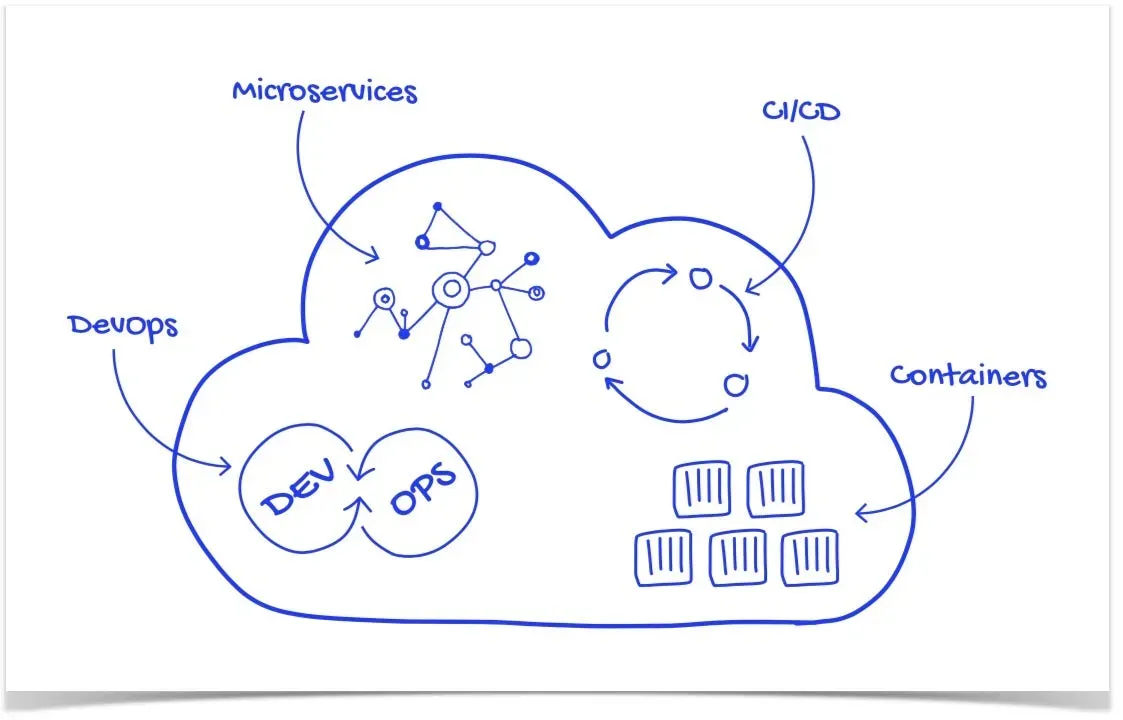
For advice on this issue, we turned to a DevOps services company. We'll look in detail at the basic principles and benefits of implementing cloud-native architecture, shedding light on how it is revolutionizing the way applications are built, scaled, and managed in the cloud era. Furthermore, we will explore the seamless integration of renowned cloud services like AWS Lambda, Azure Functions, and Google Cloud Functions, and how they empower organizations on their cloud-native journey.
Understanding Cloud-Native Architecture
At its core, cloud-native architecture is designed to leverage the dynamic nature and scalability of the cloud environment. It revolves around three key principles:
a) Microservices: Microservices follow an architectural style that involves breaking down applications into smaller, independent services. This modular approach allows for independent development, deployment, and scaling of each service, enabling greater agility and resilience.
b) Serverless Computing: Serverless computing abstracts away infrastructure management, allowing developers to focus solely on writing code. It automatically handles scaling and resource allocation, resulting in improved agility, reduced operational overhead, and cost savings.
c) Containerization: Containerization encapsulates application components along with their dependencies, providing a consistent and portable deployment environment. By leveraging containerization, organizations can achieve efficient resource utilization, simplified deployment, and easy scalability.
Advantages of Cloud-Native Architecture
The benefits of the cloud native approach are undeniable, as they help optimize application development and deployment:
- Scalability: Cloud-native architecture enables horizontal scalability, allowing organizations to handle varying workloads with ease. By independently scaling microservices or functions, businesses can ensure consistent performance and responsiveness even during peak demand.
- Flexibility: The modularity of microservices empowers developers to update, replace, or scale specific components without impacting the entire application. This flexibility facilitates rapid iteration, seamless integration of new features, and adaptation to evolving business needs.
- Cost Optimization: Cloud-native architecture offers cost efficiencies through granular scaling. Serverless computing and containerization allow resources to be allocated on demand, eliminating the need for overprovisioning and reducing idle time. This pay-as-you-go model aligns expenses with actual usage, resulting in optimized costs.
- Resilience and Fault Tolerance: The distributed nature of microservices enhances application resilience. Failures in one microservice do not affect the entire application, as other services continue to function independently. This fault isolation ensures high availability and overall system reliability.
- DevOps Enablement: Cloud-native architecture promotes DevOps practices by emphasizing automation, continuous integration, and deployment. Containerization and serverless computing streamline the deployment process, enabling rapid iterations and fostering collaboration between development and operations teams.
Leveraging Cloud Services
Cloud service providers, such as AWS, Azure, and Google Cloud, offer serverless computing options that seamlessly integrate with cloud-native architecture. Let's explore some key services:
a) AWS Lambda: AWS Lambda allows developers to run code without managing servers. It supports multiple programming languages and automatically scales based on incoming requests. With Lambda, organizations can build highly scalable and event-driven applications, reducing operational complexities.
b) Azure Functions: Azure Functions provides a serverless compute platform that integrates seamlessly with other Azure services. It supports various programming languages and enables the creation of event-driven solutions. Azure Functions empowers developers to focus on writing business logic while Azure takes care of the underlying infrastructure.
c) Google Cloud Functions: Google Cloud Functions enables the creation of event-driven functions that automatically respond to cloud events. It integrates well with other Google Cloud services and provides auto-scaling capabilities. With Google Cloud Functions, organizations can build powerful serverless applications in a flexible and efficient manner.
Conclusion
The realm of application development and deployment is being transformed by cloud-native architecture. This innovative approach embraces the principles of microservices, serverless computing, and containerization, offering a multitude of benefits to organizations.
These advantages include heightened scalability, flexibility, and cost optimization, empowering businesses to tackle the challenges of the digital era head-on. By adopting this architectural evolution, organizations can deliver exceptional applications that foster innovation and drive overall success.
Additionally, harnessing the capabilities of renowned cloud services like AWS Lambda, Azure Functions, and Google Cloud Functions takes organizations further along their cloud-native journey, allowing them to fully tap into the boundless potential of the cloud.